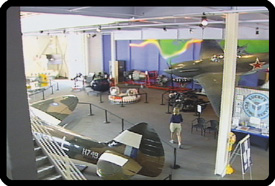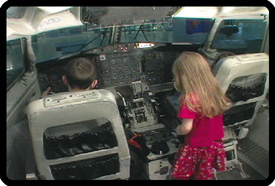MUSEUMS
AND DISPLAYS:
See for
yourself
Next time you are waiting
for a flight at your local airport, picture yourself standing next to
a striking exhibit describing an important part of your community's
history, the subject of local folklore. Or taking the controls in what
was once the cockpit of an airliner, now long retired. Or learning about
a local manufacturing firm's use of the airport while you are enroute
to a business meeting. Or watching your children enjoy an aviation oriented
playscape in the airline terminal that answers many of their incessant
questions about the airport and its equipment.
 There
are endless benefits from aviation museums and aeronautical displays.
They preserve evidence of what was once considered important. They educate.
They provide people with a sense of the past and the airport's role
in it. They predict the future and explain the need to sustain the airport
so it can continue its mission of service. Displays and museums gain
attention for aviation as almost no other form of communication can,
outside of a perfect flight on a perfect day. There
are endless benefits from aviation museums and aeronautical displays.
They preserve evidence of what was once considered important. They educate.
They provide people with a sense of the past and the airport's role
in it. They predict the future and explain the need to sustain the airport
so it can continue its mission of service. Displays and museums gain
attention for aviation as almost no other form of communication can,
outside of a perfect flight on a perfect day.
Airport museums can serve
as the linchpin for bringing together diverse organizations -- historic
groups and civic organizations, philanthropic corporate neighbors, local
or regional government -- all to preserve a place in time, and to preserve
a place called an airport. Events held at them or additions to their
collections serve as publicity makers, generating positive stories about
the facility and the airport where it's located. And aviation museums
can serve as regional resource centers for aviation and space education
curricula and programs, enhancing the missions of the surrounding school
districts.
 We
found airport museums of all sizes throughout the country. And we learned
of airport displays ranging from those on a wall or tabletop at local
airstrips to those as elaborate as Syracuse's Hancock International
Airport's comprehensive installation, which includes a wall of pictures
and sound, pieces of airport equipment, and an actual 727 cockpit. Such
exhibits gain the attention of young and old alike. We
found airport museums of all sizes throughout the country. And we learned
of airport displays ranging from those on a wall or tabletop at local
airstrips to those as elaborate as Syracuse's Hancock International
Airport's comprehensive installation, which includes a wall of pictures
and sound, pieces of airport equipment, and an actual 727 cockpit. Such
exhibits gain the attention of young and old alike.
Visit the Museums/Displays
section of the state pages to learn
where airport museums are making a difference. Better yet, visit a museum
yourself to gather some inspiration about why people who want to preserve
aviation do what they do and to get a few ideas for your own educational
display.
| The
Cockpit of this Boeing 727 never leaves Syracuse's Hancock International
Airport. Learn about the components of New Jersey's shrine to its
aviation heritage. It's all found in our Resources
Section. |
 
|